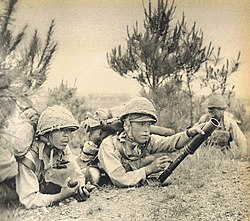| Zhejiang-Jiangxi campaign | |||||||
|---|---|---|---|---|---|---|---|
| Part of Second Sino-Japanese War | |||||||
 A Japanese soldier with 50mm heavy grenade discharger during the Zhejiang-Jiangxi Campaign, 30 May 1942. | |||||||
| |||||||
| Belligerents | |||||||
|
|
| ||||||
| Commanders and leaders | |||||||
| Huang Baitao | Shunroku Hata | ||||||
| Strength | |||||||
| 300,000 | 180,000 | ||||||
| Casualties and losses | |||||||
|
70,000 250,000 civilians | 36,000 | ||||||
| |||||
The Zhejiang-Jiangxi campaign (Japanese: 浙贛作戦, simplified Chinese: 浙赣战役; traditional Chinese: 浙赣戰役; pinyin: zheganzhanyi), refers to a campaign by the China Expeditionary Army of the Japanese Imperial Army under Shunroku Hata and Chinese 3rd War Area forces under Gu Zhutong in the Chinese provinces of Zhejiang and Jiangxi from mid May to early September, 1942.
On April 18, 1942, the United States launched the Doolittle Raid, an attack by B-25 Mitchell bombers from the USS Hornet on Tokyo, Nagoya, and Yokohama. The original plan was for the aircraft to bomb Japan and land at airfields in the unoccupied portion of China. Because the raid had to be launched earlier than planned, most of the aircraft ran out of fuel and crash-landed in the Chinese provinces of Zhejiang and Jiangxi.
Sixty four American airmen parachuted into the area around Zhejiang. Most were given shelter by the Chinese civilians but eight of the Americans were picked up by Japanese patrols; three were shot after a show trial for 'crimes against humanity'.[1]
Imperial General Headquarters was aware of possible air attack from Chinese territory on Japan. Two days before the Doolittle Raid, Headquarters set up an operational plan with the goal of defeating Chinese forces and destroying air bases. The operation started on May 15, 1942 with 40 infantry battalions and 15-16 artillery battalions of Japanese Army.[2]
The Japanese army conducted a massive search for American airmen and in the process whole towns and villages that were suspected of harboring the Americans were burned to the ground and many civilians executed.[1] The Japanese also wanted to occupy the area to prevent American air forces from establishing bases in China from which they could reach the Japanese mainland. When Japanese troops moved out of the Zhejiang and Jiangxi areas in mid-August, they left behind a trail of devastation. Chinese estimates put the death toll at 250,000 civilians.[1] The Imperial Japanese Army had also spread cholera, typhoid, plague and dysentery pathogens.[3] Around 1,700 Japanese troops died out of a total 10,000 Japanese soldiers who fell ill with disease when their own biological weapons attack rebounded on their own forces.[4][5]
Shunroku Hata, the commander of Japanese forces involved in the massacre of the 250,000 Chinese civilians, was sentenced in 1948 in part due to his "failure to prevent atrocities". He was given a life sentence but was paroled in 1954.[6]
See also[]
Notes[]
- ↑ 1.0 1.1 1.2 PBS Perilous Flight
- ↑ Schoppa, R. Keith (2011). In a Sea of Bitterness, Refugees during the Sino-Japanese War. Harvard University Press. pp. 368. ISBN 9780674059887., p.28
- ↑ Yuki Tanaka, Hidden Horrors, Westviewpres, 1996, p.138
- ↑ Chevrier & Chomiczewski & Garrigue 2004, p. 19.
- ↑ Croddy & Wirtz 2005, p. 171.
- ↑ "The Tokyo War Crimes Trial:Field Marshal Shunroku Hata". http://lib.law.virginia.edu/imtfe/person/144.
- Chevrier, Marie Isabelle; Chomiczewski, Krzysztof; Garrigue, Henri, eds (2004). The Implementation of Legally Binding Measures to Strengthen the Biological and Toxin Weapons Convention: Proceedings of the NATO Advanced Study Institute, Held in Budapest, Hungary, 2001. Volume 150 of NATO science series: Mathematics, physics, and chemistry (illustrated ed.). Springer. ISBN 140202097X. http://books.google.com/books?id=lILltXBTo8oC&printsec=frontcover&source=gbs_ge_summary_r&cad=0#v=onepage&q&f=false. Retrieved 10 March 2014.
- Croddy, Eric A.; Wirtz, James J., eds (2005). Weapons of Mass Destruction. Jeffrey A. Larsen, Managing Editor. ABC-CLIO. ISBN 1851094903. http://books.google.com/books?id=ZzlNgS70OHAC&printsec=frontcover&source=gbs_ge_summary_r&cad=0#v=onepage&q&f=false. Retrieved 10 March 2014.
- James M. Scott. The Untold Story of the Vengeful Japanese Attack After the Doolittle Raid
The original article can be found at Zhejiang-Jiangxi campaign and the edit history here.